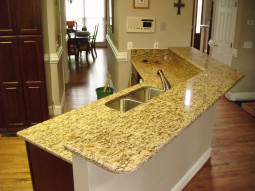 Granite Slabs offer a unique charm and elegance to the kitchen backsplash, creating the look of modern class and style; however, the mere aesthetic appeal of the backsplash isn’t the only thing contributing to its sudden popularity in interior design.
Granite Slabs offer a unique charm and elegance to the kitchen backsplash, creating the look of modern class and style; however, the mere aesthetic appeal of the backsplash isn’t the only thing contributing to its sudden popularity in interior design.
Why are people choosing the granite backsplash?
Granite, one of the hardest naturally occurring stones (next to diamonds, sapphires, and rubies), offers a unique color and pattern, and a durability and permanence that creates an incomparable and lasting value. The hard surface of the Granite Slab is resistant to scratches and heat, is easy to clean, effortless to maintain, and resists the growth of bacteria.
What are the features of the Granite Slab?
Granite Slabs offer a multitude of varying colors, including red, pink, brown, grey, black, and hundreds of varying gradients in between. The color of the stone is created by the specific minerals that were incorporated into the stone’s formation. Granite is largely composed of quartz, feldspar, and mica, and the variations in the amount of each mineral influence the resulting color of the stone. For instance, the Granite Slabs that are composed of alkali feldspar possess a distinctive pink color, while those consisting of plagioclase possess a grey coloration. Granite is largely recognized by its telltale pink coloration. In fact, the aptly named Red Pyramid of Egypt, dating back to the 26th century BC, is known for the light crimson hue of its exposed granite surfaces. Alternatively, the Black Pyramid, dating back to the reign of Amenemhat III, contained black granite pyramidion, or capstone, which are now on display in the main hall of the Egyptian Museum in Cairo.
The pattern of the stone is generally considered to be granular, although the shapes and pattern variations of the grain can vary greatly. Approximately 20% of granite’s volume is composed of quartz, which gives the stone its crystallized appearance. Granite is often classified as porphyritic, which means that its crystallized, granular texture varies greatly in size within the same specimen. This porphyritic and crystallized granular texture is what results in the unique and characteristic pattern of the Granite Slab.
Granite usually possesses a swirled, spattered, or marbled grain, a pattern which often relates to its increasing popularity. It is this dynamic pattern which marks the stunning features of the Brihadeeswarar Temple in South India, which was built entirely of granite as a dedication to Lord Shiva in 1010. The upper portion of the shrine is believed to weigh approximately 81 tonnes, and exhibits a beautiful display of the varying grain and color of the stone. The grain of the granite can include a multitude of colors, each of which can be emphasized and enhanced by the cut and finish of the Granite Slab.
How are Granite Slabs formed?
Granite Slabs are sections of granite that can be cut to specific sizes using various finishing effects in order to create customizable granite backsplashes, most often for the kitchen area, but also potentially including the areas around stairs, in washrooms, and around fireplaces. Granite is a popular kitchen material due to the fact that it is less porous, and thus is easier to clean and less likely to harbour harmful bacteria. Further, it’s unique and varying pattern can add a modern and elegant charm to your living space. Granite provides a busy, attention-grabbing look that can cater to any style.
While granite is most often cut, as with granite countertops, with a smooth, polished finish, Granite Slabs can be manufactured with varying surface textures. For instance, granite can be manufactured using a honed cut, a process which results in a smooth and unpolished finish. Alternatively, Granite Slabs can feature a flamed surface, which possesses a rough texture, or a split faced finish, which portrays the impression of the stone wall. Other popular finished include the bush hammered finish, giving the impression of weathered stone, the leathered finish, providing a rough texture while sustaining more of the vibrant color than the honed finish, and the Tuscan finish, providing a brushed weathered surface.
Alternative cuts are becoming increasingly more popular for the formation of Granite Slabs in kitchen backsplashes. The granite backsplash, regardless of the cut of the stone, provides a natural charm, while its dynamic colors and grain create a bold statement within any living space.
This article was written by Clara Whitman, who feels that granite slabs are versatile and make great kitchen countertops and backspalshes.
